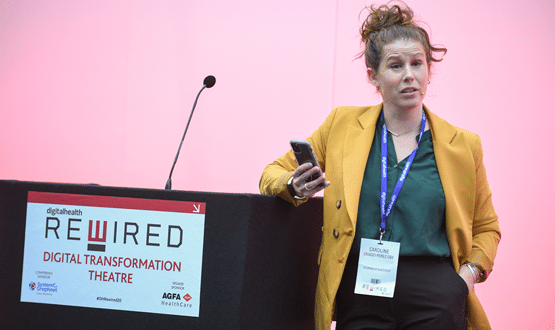Criado-Perez: Men are not a standard women fail to live up to
- 4 March 2020

Caroline Criado-Perez has one message for the audience at Digital Health Rewired 2020: “Men are not a standard women fail to live up to.”
It may seem bizarre that decisions around women’s care is often based on what is seen as a “standard person” – or Caucasian male – particularly in healthcare, but the reality is a gender data gap exists.
The first rule of the gender data gap, Criado-Perez tells us in a light-hearted and often funny talk on a serious subject, is that it’s not a conspiracy.
“It’s not the brainchild of an evil group of data scientists who got together one day back in the 50s and were like ‘we really know how we’re going to screw with women’, that was not what happened,” she jokes.
“What it is, is the product of a way of thinking that goes back millennia.”
That way of thinking is rife with unconscious bias, which affects the data we collect, who collects it and why are we collecting it.
“The way we gather data is anything but consistent because humans are not consistent,” she told the audience Olympia London on 4 March.
When we start applying that to healthcare, particularly within emerging technologies like artificial intelligence, the data gaps is no longer just a lack of information, it’s a risk to women’s lives.
And it’s about to get “a whole lot more scarier”, Criado-Perez warns.
Take, for example, heart attacks. The majority of the data we have on heart attacks – and therefore the information informing diagnoses – is based on male data.
One study from the University of Leeds found women were 50% more likely to be misdiagnosed when having a heart attack and that is purely because research centres around the symptoms men experience, not women.
“Heart disease is the number one killer of women in the US and Europe, women from lower socio-economic backgrounds are 25% more likely to sufer a heart attack than men in the same income bracket,” Criado-Perez said.
“Women are 50% more likely to be misdiagnosed if they have a heart attack in the UK, they’re also more likely to die.
“We have all this data, so why then does Google image results depict this as a wholly male problem? It’s simply because that’s the data we’ve been feeding it.”
That data is also what is used to inform algorithms, which are incredibly being used within healthcare to aide clinicians in their decision making.
But, as Criado-Perez points out, if that data doesn’t accurately represent all patients then bias will be built into new technologies. A theme TechUK president Jacqueline de Rojas also referenced in her keynote at the Leadership Summit on 3 March.
Referencing a University of Washington study, which used a dataset with a deliberate bias where pictures of cooking were 33% more likely to contain women, Criado-Perez told the audience that by the time an algorithm had finished training the disparity was increased to 68%, meaning the algorithm was mistaking men for women simply because they were next to a stove.
“It’s worrying because we know there are different risk factors for men and women when it comes to heart disease,” she adds.
“A gender-neutral risk prediction algorithm just isn’t going to cut it.”
How do we fix it?
Criado-Perez has three simple recommendations: Men are not a standard women fail to live up to; collect sex-disaggregated data; and remember diversity isn’t a tickbox.
“If you take nothing else away from this talk that is the main thing [men are not a standard women fail to live up to] and the reason that I think that is the main thing is because that is a bias that unless we recognise in ourselves we won’t every fix this.
“Because we see this bias at the heart of everything I’ve been talking about and other more concerning things, like the excuses I get from medical researchers on why they can’t include women in their trials.
“They say ‘Women are just too complicated, the menstrual cycle will interfere with the results’ – well yeah it will, but what I find really interesting about that excuse is that it presents the female body as this weird complicating factor rather than the body that represents half of humanity.”
Criado-Perez closed her keynote encouraging everyone involved in healthcare to be aware of the gender data gap and do what they can to remedy it.





1 Comments
Passionate, funny, kick-ass and hugely hugely significant contribution. Looking forward to the next chapter.
Comments are closed.